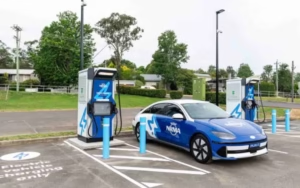Table of Contents
ToggleEnvironmental Control Technology in Australia: Innovations for a Greener Future
As Australia continues to confront the realities of climate change, environmental control technology has become a critical tool in managing pollution, reducing emissions, and protecting natural resources.
These advanced systems and methods are designed to monitor, regulate, and improve environmental conditions—across air, water, and land. From smart buildings to industrial emission control, environmental control technology is shaping how Australia addresses sustainability and environmental challenges.
In this article, we explore how environmental control technology is being used across different sectors in Australia, the latest innovations, and what the future looks like for this rapidly growing industry.
What Is Environmental Control Technology?
Environmental control technology refers to a range of systems, tools, and methods used to minimize environmental damage and improve ecological conditions. These technologies are used to:
- Reduce air and water pollution
- Monitor environmental conditions in real time
- Manage waste and industrial emissions
- Improve energy efficiency
- Ensure compliance with environmental regulations
In Australia, these technologies are vital for industries like mining, manufacturing, agriculture, and urban development. They are also essential in the construction of sustainable buildings and smart infrastructure.

Importance of Environmental Control Technology in Australia
Australia faces unique environmental challenges, including:
- Drought and water scarcity
- Bushfires and extreme weather events
- High carbon emissions in certain sectors
- Biodiversity loss
Environmental control technology helps manage these issues by offering smarter, data-driven ways to reduce harm and promote sustainability. For instance, sensor-based air quality monitoring systems are now common in Australian cities, helping to detect pollution levels and alert citizens to health risks.
Moreover, Australia’s commitment to achieving net-zero emissions by 2050 places increased emphasis on adopting clean technologies across industries. Environmental control systems make this goal achievable by integrating eco-friendly practices with efficient technology
3. Key Applications of Environmental Control Technology
1. Air Pollution Control
Australia uses technologies like electrostatic precipitators, scrubbers, and catalytic converters to control industrial emissions. Smart air monitoring stations in cities like Sydney and Melbourne track particulate matter, nitrogen oxides, and carbon dioxide levels.
2. Water Quality Management
Water-sensitive urban design (WSUD) and smart irrigation systems are popular tools. These systems monitor runoff, limit contaminants, and promote recycling of wastewater—especially in drought-prone regions.
3. Waste Management Technologies
Australia is adopting AI and automation in waste sorting, recycling, and landfill management. Environmental control systems also help track waste generation and processing metrics in real time.
4. Climate Control in Agriculture
Modern greenhouses and vertical farming setups use environmental control systems to regulate temperature, humidity, and CO₂ levels—improving yields and reducing resource use.
5. Smart Building Systems
Energy-efficient HVAC systems, automated lighting, and smart meters help buildings in Australia reduce their carbon footprint and comply with sustainability certifications like Green Star and NABERS.
4. Latest Innovations in Environmental Control Technology
Innovation in this field is moving fast. Some of the most notable advancements in Australia include:
- IoT-based Environmental Monitoring: Wireless sensors collect real-time data on air quality, soil moisture, and water pollutants. This information is crucial for rapid decision-making.
- AI and Machine Learning: Predictive algorithms are used to forecast pollution levels and automate system responses.
- Carbon Capture Technologies: Research institutions in Australia are developing carbon sequestration solutions to reduce emissions from fossil fuel industries.
- Renewable Energy Integration: Environmental control systems now work with solar and wind technologies to manage building energy use efficiently.
These technologies help industries reduce compliance costs while also supporting Australia’s sustainability goals.
Government Regulations and Support in Australia
Australia has implemented various policies and regulations to support environmental protection and encourage the adoption of environmental control technologies. Some key frameworks include:
- National Environment Protection Measures (NEPMs)
These outline standards for air, water, and soil quality across Australia. Technologies must often be installed to ensure compliance.
- Clean Energy Regulator
This federal body oversees programs like the Emissions Reduction Fund (ERF), providing incentives for adopting low-emission technologies.
- State Environmental Protection Authorities (EPAs)
States like Victoria and New South Wales have their own EPA guidelines, pushing industries to implement advanced environmental control systems.
- Green Building Standards
Australia’s NABERS and Green Star rating systems encourage environmental control technology adoption in construction projects.
Government grants and R&D support are also available for businesses developing or deploying environmental tech.
6. Environmental Control Technology in Australian Industries
1.Mining and Resources
Environmental control systems are used to manage dust, monitor groundwater contamination, and track emissions from operations. Major mining firms in Western Australia use AI to optimize water use and reduce diesel emissions.
- Agriculture
Precision farming tools help farmers reduce pesticide use and water consumption. Controlled environment agriculture (CEA) is growing in popularity, especially in urban settings.
- Manufacturing
Industries are integrating emission control units, recycling systems, and low-energy machinery to meet sustainability benchmarks and avoid fines.
- Construction
Green construction projects incorporate environmental control through better insulation, energy recovery ventilation (ERV), and greywater reuse systems.
Environmental Control and Climate Change Mitigation
Environmental control technology plays a direct role in combating climate change by:
- Reducing greenhouse gas emissions
- Lowering energy consumption
- Enhancing carbon sequestration
- Preventing environmental degradation
As global temperatures rise, Australia’s adoption of these technologies can help mitigate extreme climate impacts while supporting economic development.
Additionally, environmental tech promotes climate resilience by enabling quicker responses to environmental threats like bushfires, floods, and drought.
Challenges Facing Environmental Control Technology in Australia
Despite its promise, this sector faces several challenges:
- High Initial Costs: Many small businesses hesitate to adopt due to the expense.
- Technical Skills Shortage: There is a growing need for skilled workers in environmental engineering and data analysis.
- Policy Inconsistencies: Varying regulations between states can slow adoption.
- Resistance to Change: Some industries remain tied to outdated systems due to familiarity or perceived reliability.
However, with rising awareness and better incentives, these challenges are gradually being addressed.
The Future of Environmental Control Technology in Australia
Looking ahead, we can expect:
- Increased Automation: AI and robotics will further streamline environmental management tasks.
- Decentralized Environmental Monitoring: With more individuals and communities participating through mobile apps and sensors.
- Integration with Smart Cities: Environmental control systems will form the backbone of smart city infrastructure.
- Stronger Policy Backing: More consistent and ambitious government action is expected to support greener technology.
Australian businesses that invest early in these technologies are likely to gain a competitive advantage, reduce risk, and appeal to environmentally conscious consumers.
Conclusion
Environmental control technology offers Australia a powerful means to balance economic growth with ecological sustainability. From industrial applications to household-level energy use, these technologies are helping the country transition into a cleaner and more resilient future.
By supporting innovation, strengthening regulations, and encouraging adoption across sectors, Australia can position itself as a global leader in environmental technology.
Whether you’re a business owner, policymaker, or concerned citizen, staying informed about the latest trends in environmental control technology will be essential in navigating the challenges—and opportunities—of a rapidly changing world.






